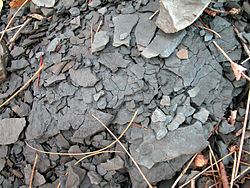Shale
Shale is a fine-grained sedimentary rock formed from mud. The mud is a mix of flakes of clay minerals and tiny fragments (silt-sized particles) of other minerals, especially quartz and calcite. The ratio of clay to other minerals is variable.[1] Shale has breaks along thin laminae (plates) or parallel layering or bedding less than one centimeter in thickness, called "fissility" (~splitting).[1] Mudstones, on the other hand, are similar, though they do not show the tendency to split (fissility).
Shales and mudrocks contain roughly 95 percent of the organic matter in all sedimentary rocks. However, this amounts to less than one percent by mass in an average shale. Black shales form in anoxic (without oxygen) conditions. They contain free carbon and iron sulfides such as pyrite. This produces the black colouration.[1]
Formation of shale
Shales are typically deposited in very slow moving water and are often found in lakes and lagoonal deposits, in river deltas, on floodplains and offshore from beach sands. They can also be deposited on the continental shelf, in relatively deep, quiet water. This process could have taken millions of years to complete.
'Black shales' are dark, and are especially rich in unoxidized carbon. Black shales are deposited in anoxic or low oxygen environments, such as in stagnant water. They are common in some Palaeozoic and Mesozoic strata. Some black shales have heavy metals such as molybdenum, uranium. vanadium, and zinc.[2][3][4] The heavy metals may have got there by slow accumulation.
Shale Media
Sample of drill cuttings of shale while drilling an oil well in Louisiana, United States. Sand grain = 2 mm in diameter
Color chart for shale based on oxidation state and organic carbon content
Splitting shale (Messel oil shale) with a large knife to reveal fossils
Weathering shale at a road cut in southeastern Kentucky
References
- ↑ 1.0 1.1 1.2 Blatt, Harvey and Robert J. Tracy 1996. Petrology: igneous, sedimentary and metamorphic. 2nd ed, Freeman, 281 - 292 ISBN 0-7167-2438-3
- ↑ R. Zangerl and E.S. Richardson 1963. The paleoecologic history of two Pennsylvanian shales. Fieldiana Memoirs 4, Field Museum of Natural History, Chicago. 352
- ↑ J.D. Vine and E.B. Tourtelot 1970. Geochemistry of black shale deposits - a summary report. Economic Geology 65 253-273
- ↑ H.D. Holland, 1979, Metals in black shales - a reassessment. Economic Geology 70 1676-1680






